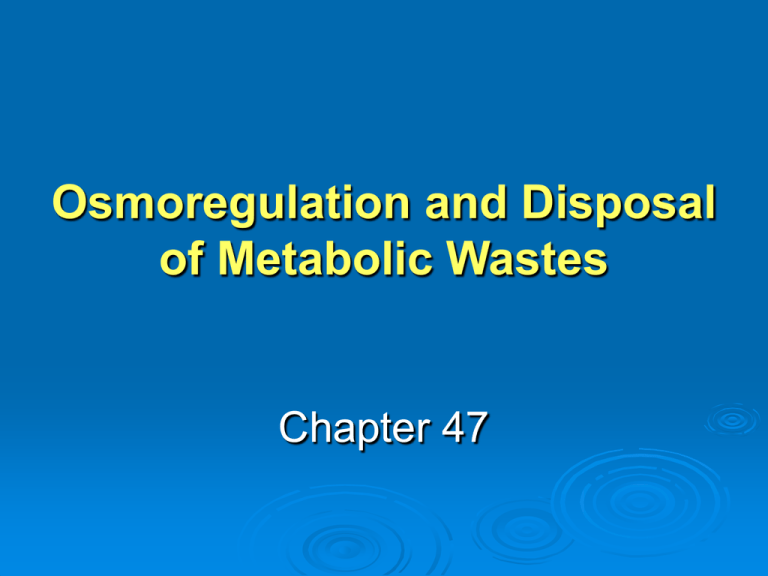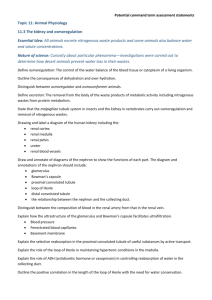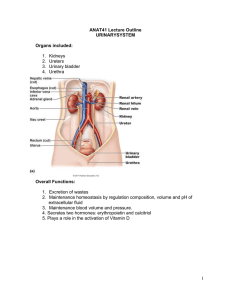Osmoregulation and Disposal of Metabolic Wastes Chapter 47
advertisement

Osmoregulation and Disposal of Metabolic Wastes Chapter 47 Learning Objective 1 • How do the processes of osmoregulation and excretion contribute to fluid and electrolyte homeostasis? Fluid-Electrolyte Homeostasis • Osmoregulation • • • active regulation of osmotic pressure of body fluids maintains fluid and electrolyte homeostasis Excretion • process of ridding body of metabolic wastes Learning Objective 2 • Contrast the benefits and costs of excreting ammonia, uric acid, or urea Nitrogenous Wastes • Ammonia (toxic) • • Urea (less toxic) • • • excreted mainly by aquatic animals synthesis requires energy excretion requires water Uric acid (less toxic) • excreted as semisolid paste (conserves water) Nitrogenous Wastes Amino acids Nucleic acids Deamination Ammonia Keto acids Purines Urea cycle 15 steps Ammonia Urea Uric acid More energy needed to produce More water needed to excrete Fig. 47-1, p. 1013 Amino acids Nucleic acids Deamination Ammonia Keto acids Purines Urea cycle 15 steps Ammonia Urea Uric acid More energy needed to produce More water needed to excrete Stepped Art Fig. 47-1, p. 1013 Learning Objective 3 • Compare osmoconformers and osmoregulators Osmoconformers • Most marine invertebrates • Salt concentration of body fluids varies with changes in sea water Osmoregulators • Some marine invertebrates • • especially in coastal habitats Maintain optimal salt concentration despite changes in salinity of surroundings KEY CONCEPTS • Osmoregulation is the process by which organisms control the concentration of water and salt in the body so that their body fluids do not become too dilute or too concentrated Learning Objective 4 • Describe protonephridia, metanephridia, and Malpighian tubules • Compare their functions Nephridial Organs • Help maintain homeostasis • • • by regulating concentration of body fluids osmoregulation excretion of metabolic wastes Protonephridia • Tubules with no internal openings • • in flatworms and nemerteans Interstitial fluid enters blind ends • flame cells (cells with brushes of cilia) • • Cilia propel fluid through tubules • Excess fluid exits through nephridiopores Protonephridia Flame cells Protonephridial network Nephridiopores Excretory tubule Flatworm Fig. 47-2ab, p. 1014 Nucleus Cytoplasm Cilia (“flame”) Movement of interstitial fluid Excretory tubule Fig. 47-2c, p. 1014 Metanephridia • Tubules open at both ends • • Fluid from coelom moves through tubule • • in most annelids and mollusks needed materials reabsorbed by capillaries Urine exits body through nephridiopores • contains wastes Metanephridia Tubule Anterior Posterior Gut Funnel Septum Nephridiopore Capillary network Fig. 47-3, p. 1014 Malpighian Tubules 1 • Extensions of insect gut wall • • Tubule cells actively transport uric acid from hemolymph into tubule • • blind ends lie in hemocoel water follows by diffusion Contents of tubule pass into gut Malpighian Tubules 2 • Water and some solutes reabsorbed in rectum • Malpighian tubules effectively conserve water • contribute to success of insects as terrestrial animals Malpighian Tubules Gut Malpighian tubules Waste Hindgut Rectum Midgut Water and needed ions Fig. 47-4, p. 1014 KEY CONCEPTS • Excretory systems have evolved that function in both osmoregulation and in disposal of metabolic wastes Learning Objective 5 • Relate the function of the vertebrate kidney to the success of vertebrates in a wide variety of habitats The Vertebrate Kidney • Excretes nitrogenous wastes • Helps maintain fluid balance by adjusting salt and water content of urine Adaptation to Habitats • Freshwater, marine, terrestrial habitats • • different problems for maintaining internal fluid balance, excretion of nitrogenous wastes Structure and function of vertebrate kidney • adapted to various osmotic challenges of different habitats KEY CONCEPTS • The vertebrate kidney maintains water and electrolyte balance and excretes metabolic wastes Learning Objective 6 • Compare adaptations for osmoregulation in freshwater fishes, marine bony fishes, sharks, marine mammals, and terrestrial vertebrates Freshwater Fishes • Take in water osmotically • excrete large volume of hypotonic urine Water gain by osmosis Loses salt by diffusion Drinks no water Salt uptake by gills Kidney with large glomeruli Large volume of hypotonic urine Fig. 47-5a, p. 1015 Marine Bony Fishes • Lose water osmotically • Compensate by drinking sea water and excreting salt through their gills • Produce only a small volume of isotonic urine Water loss by osmosis Gains salts by diffusion Drinks salt water Salt excreted through gills Kidney with small or no glomeruli Small volume of isotonic urine Fig. 47-5b, p. 1015 Sharks and Other Marine Cartilaginous Fishes • Retain large amounts of urea • • allows them to take in water osmotically through their gills Excrete large volume of hypotonic urine Water gain by osmosis Salt-excreting gland Salts diffuse in through gills Some salt water swallowed with food Kidney with large glomeruli— reabsorbs urea Large volume of hypotonic urine Fig. 47-5c, p. 1015 Marine Mammals • Ingest sea water with their food • produce concentrated urine Terrestrial Vertebrates • Must conserve water • • adaptations include efficient kidneys Endotherms • • have a high metabolic rate produce large volume of nitrogenous wastes LIVER Wastes produced ALL CELLS Hemoglobin breakdown Breakdown of nucleic acids Cellular respiration Deamination of amino acids Wastes Uric acid Bile pigments Water Carbon dioxide Urea Organs of excretion KIDNEY Excretion Urine DIGESTIVE SYSTEM Feces SKIN LUNGS Exhaled air Sweat containing water vapor and carbon dioxide Fig. 47-6b, p. 1016 KEY CONCEPTS • Freshwater, marine, and terrestrial animals have different adaptations to meet the challenges of these diverse environments Learning Objective 7 • Describe (or label on a diagram) the organs of the mammalian urinary system • Give the functions of each The Urinary System • Principal excretory system in mammals • Mammalian kidneys produce urine • • • passes through ureters to urinary bladder for storage Urine is released from the body (urination) • through the urethra Human Urinary System Adrenal gland Right kidney Left renal artery Right renal vein Left kidney Inferior vena cava Abdominal aorta Ureteral orifices Right and left ureters Urinary bladder Urethra External urethral orifice Fig. 47-7, p. 1017 Kidney Structure 1 • Renal cortex • • Renal medulla • • • outer portion of kidney inner portion of kidney contains 8 to 10 renal pyramids Renal pyramids • tip of each pyramid is a renal papilla Kidney Structure 2 • Urine flows into collecting ducts • • which empty through a renal papilla into the renal pelvis (funnel-shaped chamber) Nephrons • • functional units of kidney each kidney has more than 1 million Internal Kidney Structure Renal pyramids (medulla) Capsule Renal cortex Renal medulla Renal artery Renal vein Renal pelvis Ureter Internal structure of the kidney. Fig. 47-8a, p. 1018 Juxtamedullary nephron Distal convoluted tubule Cortical nephron Capsule Proximal convoluted tubule Renal cortex Glomerulus Bowman’s capsule Artery and vein Loop of Henle Renal medulla Collecting duct Papilla Juxtamedullary and cortical nephrons. Fig. 47-8b, p. 1018 Insert “Human kidney” kidney_anatomy_v2.swf Learning Objective 8 • Describe (or label on a diagram) the structures of a nephron (including associated blood vessels) • Give the functions of each structure Nephron Structure • Each nephron consists of • • • • a cluster of capillaries (glomerulus) surrounded by a Bowman’s capsule that opens into a long, coiled renal tubule Renal tubule consists of • • • proximal convoluted tubule loop of Henle distal convoluted tubule Types of Nephrons • Cortical nephrons • • • located mostly within cortex or outer medulla have small glomeruli Juxtamedullary nephrons • • • extend deep into medulla have large glomeruli and long loops of Henle important in concentrating urine Blood Vessels 1 • Blood flows • • • • from small branches of renal artery to afferent arterioles to glomerular capillaries into an efferent arteriole Blood Vessels 2 • Efferent arteriole • • delivers blood into peritubular capillaries that surround the renal tubule Blood leaves kidney through renal vein Nephron Structure Proximal tubule Bowman's capsule Glomerulus Efferent arteriole Afferent arteriole Peritubular capillaries Distal tubule Collecting duct From renal artery To renal vein Loop of Henle To renal pelvis (a) Location and basic structure of a nephron. Fig. 47-9a, p. 1019 Distal tubule Bowman's capsule Proximal tubule Podocyte Glomerular capillaries Afferent arteriole Afferent arteriole Juxtaglomerular apparatus Efferent arteriole Distal tubule (b) Cutaway view of Bowman’s capsule. Fig. 47-9b, p. 1019 KEY CONCEPTS • The nephron is the functional unit of the vertebrate kidney Learning Objective 9 • Trace a drop of filtrate from Bowman’s capsule to its release from the body as urine Urine Production • Filtration • • Reabsorption • • of plasma of needed materials Secretion • of potassium, hydrogen ions into renal tubule Urine Production REABSORPTION AND SECRETION Proximal tubule FILTRATION Bowman's capsule Glomerulus REABSORPTION AND SECRETION REABSORPTION OF H2O; URINE CONCENTRATED Distal tubule Collecting duct Renal artery Renal vein Capillaries To renal pelvis Loop of Henle Fig. 47-10, p. 1020 Insert “Structure of the glomerulus” glomerulus.swf Filtration 1 • Plasma filters through glomerular capillaries into Bowman’s capsule • Filtration membrane • • • permeable walls of capillaries filtration slits between podocytes Podocytes • • specialized epithelial cells make up inner wall of Bowman’s capsule Filtration Membrane Bowman's capsule Glomerulus Afferent arteriole Efferent arteriole Fig. 47-11a, p. 1021 Blood cells restricted from passing through Red blood cell Capillary pores Endothelial cell of capillary Nucleus Podocyte Filtration slits Foot processes Fig. 47-11b, p. 1021 Filtration 2 • Filtration is nonselective • • small molecules become part of filtrate glucose, other needed materials, metabolic wastes Reabsorption 1 • About 99% of filtrate is reabsorbed from renal tubules into blood • Highly selective process • • returns usable materials to blood leaves wastes, excess substances to be excreted in the urine Reabsorption 2 • Tubular transport maximum (Tm) • maximum rate at which a substance can be reabsorbed Insert “Tubular reabsorption” tubular_reabsorption_m.swf Secretion • Hydrogen ions, certain other ions, and some drugs are actively transported into renal tubule to become part of urine Water, Ion and Urea Movement Bowman's capsule Afferent arteriole Distal tubule Proximal tubule Efferent arteriole NaCl H2O Filtrate CORTEX H2O NaCl NaCl H2O NaCl MEDULLA Collecting duct H2O H2O Descending limb NaCl Urea Ascending limb Loop of Henle Fig. 47-12, p. 1022 Urine Concentration 1 • Depends on high concentration of salt and urea in interstitial fluid of kidney medulla • Concentration gradient • • salt most concentrated around bottom of loop of Henle maintained by salt reabsorption from various parts of renal tubule Urine Concentration 2 • Counterflow of fluid through two limbs of loop of Henle • • • concentrates filtrate moving down descending loop dilutes filtrate moving up ascending loop Water is drawn from filtrate by osmosis • • as it passes through collecting ducts concentrating urine in collecting ducts Urine Concentration 3 • Vasa recta • • system of capillaries extending from efferent arterioles removes some water that diffuses from filtrate into interstitial fluid Urine Concentration Distal tubule Bowman's capsule Afferent arteriole Proximal tubule 300 100 300 100 200 Efferent arteriole CORTEX Filtrate 300 100 300 300 400 200 400 400 600 400 600 600 600 Collecting duct Interstitial fluid 1200 1200 MEDULLA 1200 Loop of Henle Fig. 47-13, p. 1023 Urine • A watery solution of nitrogenous wastes, excess salts, and other substances not needed by the body Watch renal processes in action by clicking on the figures in ThomsonNOW. Learning Objective 10 • Describe the hormonal regulation of fluid and electrolyte balance by antidiuretic hormone (ADH), the renin–angiotensin– aldosterone system, and atrial natriuretic peptide (ANP) Antidiuretic Hormone (ADH) • Posterior pituitary increases ADH release • • • when body needs to conserve water responds to increase in osmotic concentration of blood (caused by dehydration) ADH increases permeability of collecting ducts to water • • more water is reabsorbed small volume of urine is produced Regulation by ADH Receptors in the hypothalamus 1 Fluid intake is low. 2 Blood volume decreases, and osmotic pressure increases. Posterior pituitary 6 Blood volume increases, 7ADH secretion 3Posterior pituitary is inhibited. and osmotic pressure secretes ADH. Collecting duct decreases. Nephron H2O H2O H2O H2O Kidney H2O 5 Water reabsorption H2O increases. 4 Collecting ducts become more Lower permeable. urine volume Fig. 47-14, p. 1024 Renin-Angiotensin-Aldosterone Pathway 1 • When blood pressure decreases • • juxtaglomerular apparatus secretes renin Renin (enzyme) • activates pathway to production of angiotensin II Renin-Angiotensin-Aldosterone Pathway 2 • Angiotensin II (hormone) • • • constricts arterioles (raises blood pressure) stimulates aldosterone release Aldosterone (hormone) • increases sodium reabsorption (raises blood pressure) Atrial Natriuretic Peptide (ANP) • When blood pressure increases • • • ANP increases sodium excretion, inhibits aldosterone secretion increases urine output, lowers blood pressure Renin-angiotensin-aldosterone pathway and atrial natriuretic peptide work antagonistically





